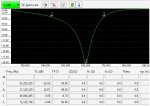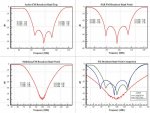- Joined
- Dec 19, 2002
- Messages
- 2,541
I measured some of my filters a while back (I did not keep the measurement for the Digikey as it was so deep, it was in the noise but it was the best filter for depth and bandwidth).
Archer (RadioShack) and similar 86.3-113.9 87.6-115.7
PAR 82.2-114.2 83.9-112.5
Stridsberg 71.7-130.8 74.7-126.8
One thing to look out for is that some filters seem to have additional significant unplanned notches in the 700-1000 MHz range. One should check up there when installing notch filters for other bands by inserting and removing the notch while monitoring signals cared about in the 700-1000 MHz range.
Archer (RadioShack) and similar 86.3-113.9 87.6-115.7
PAR 82.2-114.2 83.9-112.5
Stridsberg 71.7-130.8 74.7-126.8
One thing to look out for is that some filters seem to have additional significant unplanned notches in the 700-1000 MHz range. One should check up there when installing notch filters for other bands by inserting and removing the notch while monitoring signals cared about in the 700-1000 MHz range.







